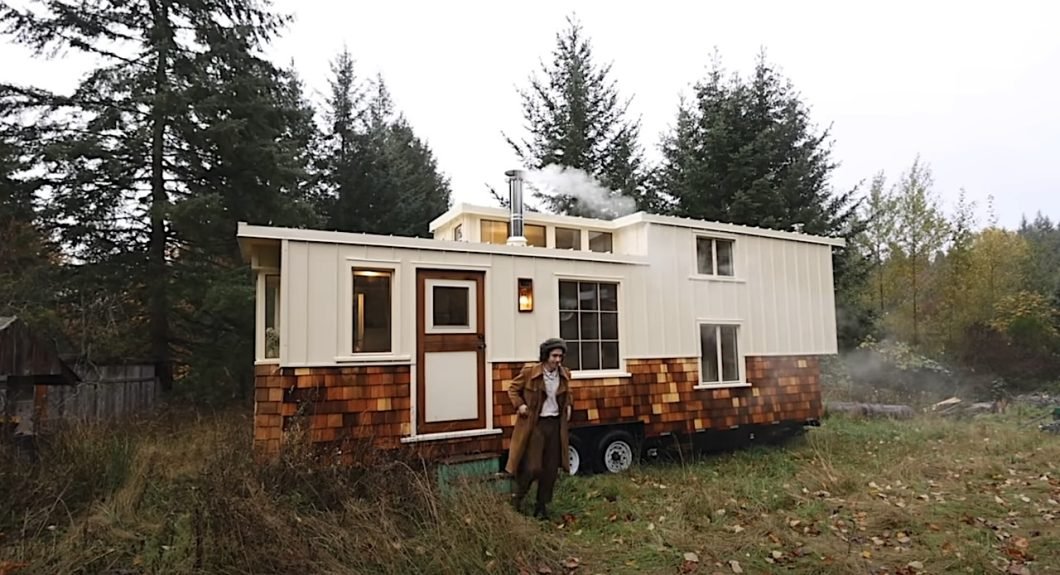Tiny House, Huge Personality

Every inch of Nick’s home has been carefully considered, from the lowered bedroom that maximizes headroom to the hand-built windows that flood the space with natural light. The U-shaped kitchen stands as a centerpiece, proving that small doesn’t mean sacrificing functionality. Blending traditional carpentry with modern tiny home design, Nick has created a space that’s both cozy and incredibly smart.
What sets this home apart are the personal touches – antique lighting, custom cabinetry, and reclaimed materials. This isn’t just a house; it’s a sanctuary that reflects Nick’s philosophy of putting love into every detail.
Watch Exploring Alternatives video below:
Key Takeaways
- Nick built the tiny home over 14 months, mostly doing it himself with minimal outside help due to budget constraints.
- The design focus was on the downstairs bedroom, eliminating a loft entirely and optimizing headspace in the bedroom with a lowered design.
- Nick’s background includes working on heritage house restoration and framing, which influenced the design and structural integrity of the tiny home.
- The tiny home has a footprint of around 300 sq. ft. on a 26-ft long trailer, with various bump-outs to maximize living space.
- To combat the rainy climate on the west coast of Canada, the exterior of the tiny home combines wood and metal sheathing for durability.
- A unique feature of the build is the 20 windows, which provide ample natural light and contribute to the home’s cozy and open feel.
- The tiny home is wired with 50 amps of electricity, allowing for more flexibility in usage compared to a standard RV, and includes a creative porch lighting system.
- The kitchen is located at the far end of the tiny home, a design choice that provides ample space for cooking and baking, with custom oak countertops and a propane-powered oven.
- The flooring is made from antique old-growth Douglas fir from a 1930s home, which adds character and warmth to the space.
- The lowered bedroom design was achieved by altering the trailer’s frame, adding 17 inches of extra headroom, making the bedroom feel more spacious and cozy.

Questions and Answers
What was the main design focus for this tiny home build?
The primary design focus was the downstairs bedroom. Nick wanted to eliminate the loft entirely and create a functional space without sacrificing comfort.
Why did Nick choose to avoid using a loft in this tiny home?
Nick aimed to create a more accessible and comfortable bedroom space without the need for a loft, which can often feel cramped in tiny homes. The design focused on optimizing space on the main floor.

How did Nick incorporate his carpentry experience into this tiny home build?
Nick’s experience in Heritage House restoration and framing informed many of the design decisions. His knowledge of Victorian-style homes and structural integrity helped him craft a robust and unique tiny home.

What is the overall size of the tiny home, and how is it built?
The tiny home is built on a 26-foot trailer and measures approximately 8.5 feet by 30 feet, with a total square footage around 300 sq. ft. It features a combination of traditional house framing and RV-style techniques.
Why did Nick choose metal for the exterior overhang instead of wood?
Nick opted for metal to better handle the rainy climate of the west coast of Canada. Metal offers superior durability and weather resistance compared to wood, ensuring the tiny home remains functional and low-maintenance.

How does the tiny home’s electrical system differ from typical RVs?
This tiny home uses a 50-amp electrical system, which is 20 amps more than a typical RV. It allows for additional appliances or a small shop to be run on a separate circuit, making it more versatile and energy-efficient.

What is unique about the windows in this tiny home?
The tiny home features 20 windows with 48 individual window panes. Nick prefers wooden windows for their aesthetic and natural light, which enhances the cozy feel of the small space.

How did Nick solve the challenge of headroom in the downstairs bedroom?
Nick lowered the bedroom floor by 17 inches, making use of unused space beneath the trailer to create extra headroom. This innovative solution adds more comfort without compromising the overall design.
What materials were used for the flooring in this tiny home?
The flooring is made from antique Douglas fir planks salvaged from a house built in the 1930s. These original, unsanded floors bring a sense of history and warmth to the tiny home.

How does the kitchen layout in this tiny home differ from typical designs?
Nick positioned the kitchen at the end of the tiny home, which is a unique choice. This layout maximizes the kitchen’s functionality while freeing up space for the living room, providing a better cooking and baking experience.
In conclusion, Nick’s tiny home is more than just a living space – it’s a testament to creativity, skill, and personal vision. By combining his restoration expertise, innovative design, and resourceful approach, he’s created a home that proves big dreams don’t require big square footage. From the hand-crafted windows to the reclaimed Douglas fir flooring, every detail tells a story of passion and ingenuity.
Whether you’re a tiny home enthusiast or simply someone who appreciates craftsmanship, Nick’s journey shows us that with vision and determination, we can transform limited space into a truly extraordinary home. His tiny house isn’t just a dwelling – it’s an inspiration.
